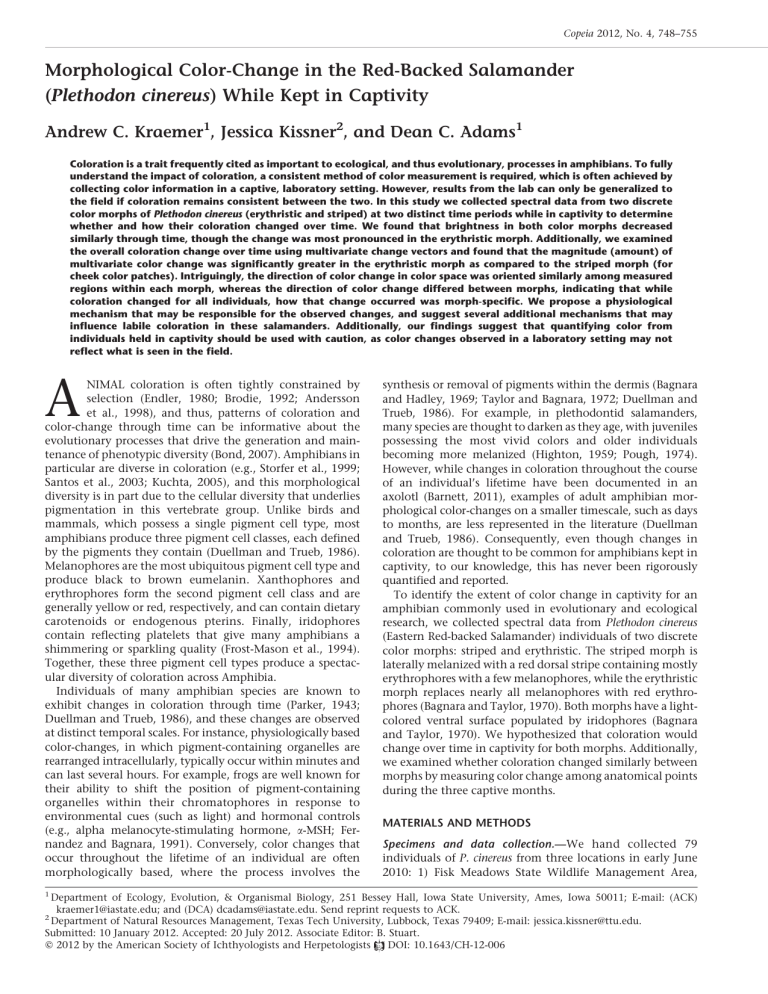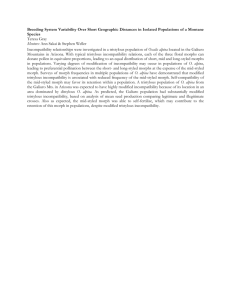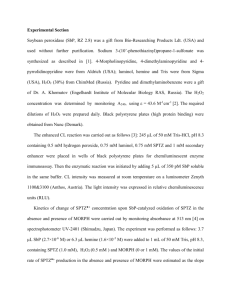Morphological Color-Change in the Red-Backed Salamander Andrew C. Kraemer , Jessica Kissner

Copeia 2012, No. 4, 748–755
Morphological Color-Change in the Red-Backed Salamander
( Plethodon cinereus ) While Kept in Captivity
Andrew C. Kraemer
1
, Jessica Kissner
2
, and Dean C. Adams
1
Coloration is a trait frequently cited as important to ecological, and thus evolutionary, processes in amphibians. To fully understand the impact of coloration, a consistent method of color measurement is required, which is often achieved by collecting color information in a captive, laboratory setting. However, results from the lab can only be generalized to the field if coloration remains consistent between the two. In this study we collected spectral data from two discrete color morphs of Plethodon cinereus (erythristic and striped) at two distinct time periods while in captivity to determine whether and how their coloration changed over time. We found that brightness in both color morphs decreased similarly through time, though the change was most pronounced in the erythristic morph. Additionally, we examined the overall coloration change over time using multivariate change vectors and found that the magnitude (amount) of multivariate color change was significantly greater in the erythristic morph as compared to the striped morph (for cheek color patches). Intriguingly, the direction of color change in color space was oriented similarly among measured regions within each morph, whereas the direction of color change differed between morphs, indicating that while coloration changed for all individuals, how that change occurred was morph-specific. We propose a physiological mechanism that may be responsible for the observed changes, and suggest several additional mechanisms that may influence labile coloration in these salamanders. Additionally, our findings suggest that quantifying color from individuals held in captivity should be used with caution, as color changes observed in a laboratory setting may not reflect what is seen in the field.
A NIMAL coloration is often tightly constrained by selection (Endler, 1980; Brodie, 1992; Andersson et al., 1998), and thus, patterns of coloration and color-change through time can be informative about the evolutionary processes that drive the generation and maintenance of phenotypic diversity (Bond, 2007). Amphibians in particular are diverse in coloration (e.g., Storfer et al., 1999;
Santos et al., 2003; Kuchta, 2005), and this morphological diversity is in part due to the cellular diversity that underlies pigmentation in this vertebrate group. Unlike birds and mammals, which possess a single pigment cell type, most amphibians produce three pigment cell classes, each defined by the pigments they contain (Duellman and Trueb, 1986).
Melanophores are the most ubiquitous pigment cell type and produce black to brown eumelanin. Xanthophores and erythrophores form the second pigment cell class and are generally yellow or red, respectively, and can contain dietary carotenoids or endogenous pterins. Finally, iridophores contain reflecting platelets that give many amphibians a shimmering or sparkling quality (Frost-Mason et al., 1994).
Together, these three pigment cell types produce a spectacular diversity of coloration across Amphibia.
Individuals of many amphibian species are known to exhibit changes in coloration through time (Parker, 1943;
Duellman and Trueb, 1986), and these changes are observed at distinct temporal scales. For instance, physiologically based color-changes, in which pigment-containing organelles are rearranged intracellularly, typically occur within minutes and can last several hours. For example, frogs are well known for their ability to shift the position of pigment-containing organelles within their chromatophores in response to environmental cues (such as light) and hormonal controls
(e.g., alpha melanocyte-stimulating hormone, a -MSH; Fernandez and Bagnara, 1991). Conversely, color changes that occur throughout the lifetime of an individual are often morphologically based, where the process involves the synthesis or removal of pigments within the dermis (Bagnara and Hadley, 1969; Taylor and Bagnara, 1972; Duellman and
Trueb, 1986). For example, in plethodontid salamanders, many species are thought to darken as they age, with juveniles possessing the most vivid colors and older individuals becoming more melanized (Highton, 1959; Pough, 1974).
However, while changes in coloration throughout the course of an individual’s lifetime have been documented in an axolotl (Barnett, 2011), examples of adult amphibian morphological color-changes on a smaller timescale, such as days to months, are less represented in the literature (Duellman and Trueb, 1986). Consequently, even though changes in coloration are thought to be common for amphibians kept in captivity, to our knowledge, this has never been rigorously quantified and reported.
To identify the extent of color change in captivity for an amphibian commonly used in evolutionary and ecological research, we collected spectral data from Plethodon cinereus
(Eastern Red-backed Salamander) individuals of two discrete color morphs: striped and erythristic. The striped morph is laterally melanized with a red dorsal stripe containing mostly erythrophores with a few melanophores, while the erythristic morph replaces nearly all melanophores with red erythrophores (Bagnara and Taylor, 1970). Both morphs have a lightcolored ventral surface populated by iridophores (Bagnara and Taylor, 1970). We hypothesized that coloration would change over time in captivity for both morphs. Additionally, we examined whether coloration changed similarly between morphs by measuring color change among anatomical points during the three captive months.
MATERIALS AND METHODS
Specimens and data collection.— We hand collected 79 individuals of P. cinereus from three locations in early June
2010: 1) Fisk Meadows State Wildlife Management Area,
1 Department of Ecology, Evolution, & Organismal Biology, 251 Bessey Hall, Iowa State University, Ames, Iowa 50011; E-mail: (ACK) kraemer1@iastate.edu; and (DCA) dcadams@iastate.edu. Send reprint requests to ACK.
2
Department of Natural Resources Management, Texas Tech University, Lubbock, Texas 79409; E-mail: jessica.kissner@ttu.edu.
Submitted: 10 January 2012. Accepted: 20 July 2012. Associate Editor: B. Stuart.
F 2012 by the American Society of Ichthyologists and Herpetologists DOI: 10.1643/CH-12-006
Kraemer et al.—Color change in a salamander
Hampshire County, MA (42.39
u N, 72.82
u W; n 5 27); 2) Elk
State Park, Elk County, PA (41.60
u N, 78.48
u W; n 5 23); and
3) Aurora Sanctuary, Portage County, OH (41.30
u N,
81.31
u W; n 5 29). All sites were between 330 and 640 m in elevation and consisted primarily of hemlock and northern hardwood forest. Ambient temperatures at the time of collection ranged from 17 u C at the Ohio site to 25 u C at the Massachusetts site. We collected salamanders by searching under cover objects such as logs, flat stones, and bark. Of the salamanders collected, 50 individuals were the striped morph and 29 were the erythristic morph. After capture, we placed each individual within its own 14 3
1.5 cm circular petri dish accompanied by a wet paper towel and placed all individuals within a humid cooler kept at
15 u C for transportation back to the laboratory at Iowa State
University. In captivity, we maintained each individual in a
14 3 1.5 cm circular petri dish with a damp paper towel.
Every three days, we fed the salamanders 4–6 live fruit flies or ants in a randomized fashion such that all salamanders were fed an equal mix of flies and ants during the captive period. No animals died during the course of this study. We placed all salamanders in a temperature-controlled chamber
(15 u C), and randomly rotated their positions within the chamber after each feeding. Light conditions are known to influence physiological color-change in many amphibians
(Duellman and Trueb, 1986), but this has not been observed in P. cinereus.
To control for any physiological color-change due to light in this nocturnal species, we kept animals in dark conditions for the entire captive period. Paper towels were changed as needed.
We quantified color using reflectance spectrometry from
18 anatomical points on each animal to ensure that all major body regions were measured (Fig. 1). Prior to obtaining spectral measurements, we anesthetized individuals in a tricaine methanesulfonate (MS-222) solution of
0.2 mg/mL. Although a procedure involving anesthetization could potentially influence physiological changes in coloration, we are not aware of any record of physiological colorchange for any plethodontid salamander, nor did we observe any physiological color-change in our salamanders.
We then measured spectral reflectance using a Jaz spectrometer (OceanOptics, Dunedin, FL) with a 100 m m entrance slit, LS-1 Tungsten Halogen lamp, and a QR400-
7-UV-BX reflectance probe fitted with a handmade tip that restricted the measured patch to a 2 mm diameter circle. The probe was held 90 u to the surface of the salamanders at a distance of 20 mm. A Spectralon white reflectance standard was used between each animal to correct for drift in lamp intensity. Each spectrum was measured at 1 nm intervals within the human visual spectrum (400 to 700 nm). The first set of spectral measurements was taken three weeks after collection (5–10 July 2010), and the second set of spectral measurements was taken three months after the first measurements (4–9 October 2010).
Statistical analyses.— We performed principal components analysis on the spectral data to obtain a set of color variables for statistical comparison ( sensu Endler and The´ry, 1996;
Grill and Rush, 2000; Rosenblum, 2006). In this representation, PC1 is interpreted as brightness, or the total amount of light reflected from each patch, while the remaining PCaxes describe aspects of chroma and hue (henceforth, coloration: see Endler, 1990; Endler and The´ry, 1996; Grill and Rush, 2000). In our case, PC1 was highly correlated with
749
Fig. 1.
(A) Locations of 18 regions where spectra were collected on each animal. Do1–Do6 correspond to the dorsal regions, Ch1 and Ch2 to the left and right cheek regions, La1–La6 to the lateral regions, and
Vn1–Vn4 to the four ventral regions. (B) Representative images of each salamander morph: striped morph at top, with erythristic morph below.
(C) Average spectra across all body regions for each morph and time point.
an independent measure of overall intensity (brightness 5
Q t
; sensu Endler, 1990, r .
0.98), indicating that interpreting
PC1 as brightness was warranted for our data. The remaining principal component axes (PC
2
–PC
301
) described the shape of the spectral curve and thus the color that each spectrum represented.
To examine variation in brightness, we performed an analysis of variance (ANOVA) to determine whether brightness
750 Copeia 2012, No. 4
Fig. 2.
Boxplots of brightness at each region and time point. White boxes correspond to the first measurement at each region, while the adjacent gray box corresponds to the second measurement at each region. Asterisks below each region label denotes the significance of the change associated with that region, where (*) P , 0.05 and (**) P , 0.01.
differed between groups (groups were defined as each measured point on each morph at each time point). To identify how brightness changed between time points for each group, we conducted a series of planned post-hoc comparisons between time points for each measured region using t-tests, as well as a Fisher’s combined probability test on these values to obtain an overall estimate of whether changes in brightness were generally prevalent across the body in each morph.
Differences in coloration were examined using permutational multivariate analysis of variance (perm-MANOVA;
Anderson, 2001) at each anatomical point, with morph and time as main effects, and including the morph 3 time interaction. Permutational-MANOVA was used in this case because the number of variables exceeded the number of specimens. Separate analyses were performed on coloration from each anatomical point. Additionally, we used multivariate vector analyses (Collyer and Adams, 2007; Adams and Collyer, 2009) to compare the magnitudes and trajectories of color change between groups and specifically to identify whether any observed changes in coloration were concordant between color morphs. Here, the magnitude and direction of color change were quantified from the least squares means for each group and statistically evaluated using residual randomization. Briefly, the observed pairwise differences between groups (measured as Euclidean distances) were first obtained from the least-squares (LS) means of the MANOVA model containing all factors (morph, time, morph 3 time). A reduced model lacking the interaction term was then calculated, from which predicted values and residuals were obtained for all specimens. Residual values were then randomized and added to the predicted values, the full model was recalculated, and pairwise distances between LS means were obtained. The proportion of randomly generated distances greater than the observed was then treated as the significance of each pairwise
Kraemer et al.—Color change in a salamander 751
Table 1.
Results from the Vector Analysis of Coloration. The left columns describe the magnitude of color change for each morph at a particular region, while the right columns summarize the angle between the subsequent vectors. Single asterisks denote a significance level of 0.05
.
0.01, and double asterisks denote a significance level of 0.01
.
0.001.
Point
Do1
Do2
Do3
Do4
Do5
Do6
Ch1
Ch2
La1
La2
La3
La4
La5
La6
Vn1
Vn2
Vn3
Vn4
Erythristic
18.384
20.943
19.785
19.538
19.830
18.063
26.407
34.244
25.656
22.405
21.407
22.860
19.600
22.746
30.712
20.418
19.449
20.098
Magnitude
Striped
23.279
20.031
20.690
20.032
19.545
20.013
16.254
19.360
17.565
16.664
19.587
19.638
21.120
18.872
22.479
17.864
14.376
17.047
P
0.231
0.826
0.854
0.905
0.936
0.618
0.010 *
0.011 *
0.107
0.179
0.685
0.491
0.759
0.373
0.122
0.557
0.484
0.427
Angle
23.938
33.282
30.774
32.710
31.877
28.737
45.347
47.620
35.572
45.744
38.493
41.897
37.707
45.658
9.706
29.010
23.068
35.397
P
0.039 *
0.098
0.13
0.108
0.128
0.116
0.011 *
0.004 **
0.016 *
0.017 *
0.018 *
0.004 **
0.011 *
0.007 **
0.828
0.043 *
0.510
0.013 * comparison (for statistical details see: Adams and Collyer,
2007, 2009; Collyer and Adams, 2007; also Anderson and
Ter Braak, 2003).
Finally, for each group we calculated the multivariate dispersion in color space (using ‘betadisper’ in the Vegan library in R), which were compared among groups using permutation. All statistical analyses were performed in R
2.13 (R Development Core Team, 2011).
RESULTS
Over 98 % of the total variation in spectra was explained by
PC1, indicating that the vast majority of spectral differences among individuals were due to differences in overall brightness. The ANOVA identified significant differences between morph 3 anatomical point 3 time groups ( F
72,2768
5 23.105; P
, 0.001), and a Fisher’s combined probability test identified a significant concordance in the change of brightness between time periods among the measured points ( x 2 5 175.994; P ,
0.001). Furthermore, the t-tests conducted between time points demonstrated that brightness decreased at most measured points dorsally and laterally on both morphs, while the ventral surfaces tended to increase in brightness (Fig. 2).
We found significant differences in overall coloration between morphs and between time periods for most anatomical regions, as well as significant morph 3 time interactions (Table 1). These results were consistent for all dorsal, cheek, and lateral regions, though three of the four ventrally located points did not have significant morph 3 time interaction terms. Multivariate vector analysis revealed a significant color change in the cheek region of erythristic individuals between time points (Table 2). The direction of color change was consistent between dorsal and lateral regions within morphs, but diverged significantly between the two morphs (Fig. 3; Table 2). Finally, the individual tests of multivariate dispersion in color space for each group revealed that all measured points displayed a significant increase in multivariate dispersion through time with the exception of the dorsal region of the erythristic individuals
(overall test of dispersion between time points: F
72,2768
5
9.0369; P , 0.001; see Table 3 for individual group P -values).
DISCUSSION
Testing evolutionary hypotheses often requires that complex phenotypic traits (e.g., coloration) are quantified and compared to the selective environments in which they evolve. In this study, we obtained spectral measurements of two morphs of
Plethodon cinereus . We observed a general trend of decreasing brightness of dorsal and lateral pigmentation over time, with captive salamanders losing reflectance relative to when they were recently caught, resulting in individuals that appeared darker after three months in captivity. Conversely, ventral reflectance increased in both morphs. These results are particularly intriguing considering that these salamanders were kept in dark conditions, as it is not well established how light can affect pigment synthesis in amphibians. Because iridophores are highly reflective relative to melanophores and erythrophores, we hypothesize that the changes in brightness we observed were the result of an upregulation of dermal pigments, which could result in a loss of reflectance in dorsal and lateral regions and an increase of reflectance in ventral regions. Future research focusing on the cellular aspects of dermal pigmentation in this system could address this hypothesis.
In addition to observations of overall brightness, we measured coloration at 18 anatomical points on every individual. First, we found that variation in coloration among individuals increased over time for all groups. Most intriguingly, while the coloration of each morph changed over time to a similar degree, the direction of change in color space differed significantly between morphs. The distinct distribution of pigments in the skin of each morph may explain the non-parallel changes of coloration between morphs. While the striped morph produces melanin
752 Copeia 2012, No. 4
Table 2.
Results from the Permutational MANOVA on Coloration between Morphs and Time Points at Each Anatomical Point. Single asterisks denote a significance level of 0.05
.
0.01, double asterisks denote a significance level of 0.01
.
0.001, and triple asterisks denote a significance level of
.
0.001.
Point
Do1
Do2
Do3
Do4
Do5
Do6
Ch1
Ch2
La1
La2
La3
La4
La5
La6
Vn1
Vn2
Vn3
Vn4
Factor
Morph
Time
Morph 3 Time
Morph
Time
Morph 3 Time
Morph
Time
Morph 3 Time
Morph
Time
Morph 3 Time
Morph
Time
Morph 3 Time
Morph
Time
Morph 3 Time
Morph
Time
Morph 3 Time
Morph
Time
Morph 3 Time
Morph
Time
Morph 3 Time
Morph
Time
Morph 3 Time
Morph
Time
Morph 3 Time
Morph
Time
Morph 3 Time
Morph
Time
Morph 3 Time
Morph
Time
Morph 3 Time
Morph
Time
Morph 3 Time
Morph
Time
Morph 3 Time
Morph
Time
Morph 3 Time
Morph
Time
Morph 3 Time
Sum Sq
18601
14087
1070
5439
13892
852
25275
13430
3287
5500
17554
896
16120
15121
1271
19299
15314
1066
19663
14426
1142
25061
20375
6000
22872
15113
2144
26247
11849
2373
30596
14534
1703
22154
15017
2202
22502
15115
1608
32356
13897
2510
1245
25507
804
1059
13124
900
1131
10005
647
2957
11806
1243
F value
20.812
66.426
3.389
30.7383
28.8328
2.4229
40.845
32.411
2.255
42.064
30.862
2.442
38.771
29.362
2.230
11.4933
29.3569
1.8008
80.669
42.864
10.492
77.029
62.627
18.442
69.852
46.158
6.549
91.870
41.475
8.307
111.749
53.084
6.220
74.774
50.687
7.432
77.023
51.736
5.505
114.970
49.382
8.919
2.887
59.140
1.863
2.829
35.066
2.404
1.3916
12.311
0.7955
8.154
32.560
3.429
P
0.001 ***
0.001 ***
0.010 *
0.001 ***
0.001 ***
0.090
0.001 ***
0.001 ***
0.100
0.001 ***
0.001 ***
0.073
0.001 ***
0.001 ***
0.093
0.001 ***
0.001 ***
0.143
0.001 ***
0.001 ***
0.001 ***
0.001 ***
0.001 ***
0.001 ***
0.001 ***
0.001 ***
0.003 **
0.001 ***
0.001 ***
0.001 ***
0.001 ***
0.001 ***
0.005 **
0.001 ***
0.001 ***
0.003 **
0.001 ***
0.001 ***
0.002 **
0.001 ***
0.001 ***
0.001 ***
0.031 *
0.001 ***
0.129
0.028 *
0.001 ***
0.053
0.217
0.001 ***
0.540
0.001 ***
0.001 ***
0.006 **
Kraemer et al.—Color change in a salamander 753
Fig. 3.
Principal components plot of color variation of Plethodon . Data from erythristic individuals are shaded in gray, while open shapes represent striped individuals. In addition, circles represent individuals from the first time point, while diamonds depict the second measured time point. The least squares mean is displayed for each group. Dotted lines correspond to the striped morph vectors, while the solid lines correspond to erythristic vectors. All data are plotted in the second and third principal components, which represent approximately 79 % of the remaining variation after the first principal component (brightness) is removed. Only group means are shown for clarity.
laterally on either side of the drosopterin-rich stripe region
(Bagnara and Taylor, 1970), the erythristic morph produces melanin exclusively in the most distal regions of the tail, while replacing melanin with drosopterins across the rest of the body (Matthews, 1952). Conversely, the difference in ventral pigmentation between morphs appears minor. By placing our work in this context, we hypothesize that an increase in the synthesis of drosopterins, melanin, and reflecting platelets could account for the non-parallel color changes at the dorsal and lateral points, while color changed in a similar manner between morphs at the ventral points.
An upregulation of dermal pigments, therefore, may result in both the changes in brightness that we observed as well as the changes in pigmentation, and therefore could be addressed together in future cellular-based research.
Ecologically, several mechanisms may influence the changes in brightness and coloration that we observed. For example, dietary changes from the wild to captivity may make the precursors for pigments more readily available, or stress may influence the regulation of hormones important for pigment synthesis (e.g., a -MSH; Fernandez and Bagnara,
1991), potentially affecting the rate of pigment synthesis and thus concentration in the dermis. Conversely, the changes we observed may reflect natural seasonal changes in
754 Copeia 2012, No. 4
Table 3.
Summary of Multivariate Dispersion. Left columns summarize the average distance from all data points in each group to the centroid of that respective group for erythristic individuals, as well as the permuted P -value between the estimates of dispersion from time point 1 to time point 2 for each anatomical point. Right columns represent the same statistics for striped individuals.
Point
Do1
Do2
Do3
Do4
Do5
Do6
Ch1
Ch2
La1
La2
La3
La4
La5
La6
Vn1
Vn2
Vn3
Vn4
Time 1
14.69
17.84
16.47
17.71
17.95
17.57
13.40
12.37
12.91
15.43
15.71
12.81
13.82
14.32
11.78
15.47
16.29
14.88
Erythristic
Time 2
17.94
23.03
19.30
21.65
21.69
20.89
23.18
24.00
19.36
19.54
20.54
21.30
21.69
22.99
24.58
20.24
20.42
23.25
P
0.044
0.019
0.077
0.060
0.085
0.132
0.001
0.001
0.001
0.028
0.003
0.001
0.001
0.001
0.001
0.028
0.033
0.001
Time 1
10.87
16.06
16.33
16.66
17.45
16.49
11.88
10.33
11.06
10.22
10.20
10.98
10.27
10.26
14.13
14.81
14.63
13.91
Striped
Time 2
17.02
23.29
22.99
21.16
21.11
22.96
17.34
19.29
20.12
17.35
16.23
18.40
17.14
16.16
22.74
20.23
24.44
19.37
P
0.001
0.003
0.009
0.076
0.005
0.001
0.001
0.001
0.001
0.001
0.001
0.001
0.001
0.108
0.001
0.001
0.034
0.044
pigmentation. For instance, if selection for pigmentation varies seasonally, individuals with an ability to seasonally reallocate resources to and from pigmentation may have higher survival rates through hot summer months. This has already been hypothesized to affect the evolution of pigmentation in other amphibian species: some Pacific
Treefrogs ( Pseudacris regilla ) have the ability to seasonally adjust their coloration to match the predominant background color (Wente and Phillips, 2005). Alternatively, if the selective environment for salamander coloration is highly variable, the ability to increase or decrease the production of dermal pigments in response to short-term environmental cues could be a valuable asset (for an example involving carotenoids and Betta fish, see Clotfelter et al., 2007). Future research on morphological color-change in amphibians should focus on teasing apart the ultimate mechanisms responsible for labile pigmentation.
Despite the clear patterns we observed in this study, a number of caveats must be considered when interpreting our findings biologically. First, our study only examined pigmentation changes in the visible spectrum (400–700 nm); the ultraviolet portion of the spectrum (300–400 nm) was not quantified. Therefore, while we observed clear changes in pigmentation over time in our study, any ultraviolet changes which may be detectable by avian predators (Hart and Hunt, 2007) cannot be addressed here. Second, any changes in pigmentation which may have occurred prior to the first quantification of color cannot be evaluated. Finally, because we did not quantify pigmentation in the field at the time of capture, any pigmentation differences between wildcaught and captive animals cannot be fully evaluated with these data. Future studies should investigate these aspects of pigmentation change in this group.
Finally, because we observed a temporal shift in coloration in captivity, our findings may also indicate that quantitative measures of coloration obtained in a laboratory setting may not approximate those obtained in natural conditions.
While we did not directly measure color in the field, the observed shifts in a laboratory setting tentatively suggest that there may be differences in coloration between captive and wild amphibians. This is especially relevant for studies where the goal is to identify relative differences or similarities in coloration between organisms that differ only subtly in coloration. As a consequence, we suggest that studies aimed at comparing finescale variation in coloration among individuals or between groups of amphibians should directly measure wild-caught individuals. In conclusion, this study provides the first rigorous quantification of morphological color-change in a salamander.
Consistent with common expectations of the effect captivity has on amphibian pigmentation, we found significant changes both in brightness and coloration. Surprisingly, we also observed that color change was morph-dependent. These findings suggest that selection on morphological color-change may affect color morphs in a different manner, which adds a new and unforeseen dimension to our understanding of the evolution of pigmentation in amphibians.
ACKNOWLEDGMENTS
The authors would like to thank the Massachusetts Division of
Fisheries and Wildlife ( # 145.10SCRA), the Pennsylvania Department of Conservation and Natural Resources ( # 492), the
Pennsylvania DCNR-Bureau of Forestry (SFRA-1016), the Ohio
Division of Wildlife ( # 11-281), and the Ohio Division of Natural
Areas and Preserves ( # RP-10-06) for the required permits to conduct this research. C. Kraemer graciously helped collect salamanders for the project. T. Robinson and T. French were instrumental in locating appropriate collection sites in Ohio and
Massachusetts, respectively. We also thank J. Gassman for the salamander illustration in Figure 1. A. Alejandrino, J. Deitloff, A.
Kaliontzopoulou, J. Serb, and A. Worthington provided valuable comments on earlier versions of this manuscript. This research was conducted under Iowa State University Institutional Animal
Care and Use Committee permit number 2-10-6881-J.
Kraemer et al.—Color change in a salamander 755
LITERATURE CITED
Adams, D. C., and M. L. Collyer . 2007. Analysis of character divergence along environmental gradients and other covariates. Evolution 61:510–515.
Adams, D. C., and M. L. Collyer . 2009. A general framework for the analysis of phenotypic trajectories in evolutionary studies. Evolution 63:1143–1154.
Anderson, M. J.
2001. A new method for non-parametric multivariate analysis of variance. Austral Ecology 26:32–46.
Anderson, M. J., and C. J. F. Ter Braak . 2003. Permutation tests for multi-factorial analysis of variance. Journal of
Statistical Computation and Simulation 73:85–113.
Andersson, S., J. Ornborg, and M. Andersson . 1998.
Ultraviolet sexual dimorphism and assortative mating in blue tits. Proceedings of the Royal Society: Biological
Sciences 265:445–450.
Bagnara, J. T., and M. E. Hadley . 1969. The control of bright colored pigment cells of fishes and amphibians.
American Zoologist 9:465–478.
Bagnara, J. T., and J. D. Taylor . 1970. Differences in pigmentcontaining organelles between color forms of red-backed salamander, Plethodon cinereus . Zeitschrift Fur Zellforschung
Und Mikroskopische Anatomie 106:412–417.
Barnett, J.
2011. Pigmentation loss and regeneration in a captive wild-type axolotl, Ambystoma mexicanum.
Herpetological Bulletin 115:17–18.
Bond, A. B.
2007. The evolution of color polymorphism: crypticity, searching images, and apostatic selection.
Annual Review of Ecology and Systematics 38:489–514.
Brodie, E. D., III.
1992. Correlational selection for color pattern and antipredator behavior in the garter snake
Thamnophis ordinoides . Evolution 46:1284–1298.
Clotfelter, E. D., D. R. Ardia, and K. J. McGraw . 2007. Red fish, blue fish: trade-offs between pigmentation and immunity in Betta splendens . Behavioral Ecology 18:1139–1145.
Collyer, M. L., and D. C. Adams . 2007. Analysis of two-state multivariate phenotypic change in ecological studies.
Ecology 88:683–692.
Duellman, W. E., and L. Trueb . 1986. Biology of Amphibians. Johns Hopkins University Press, Baltimore, Maryland.
Endler, J. A.
1980. Natural selection on color patterns in
Poecilia reticulata . Evolution 34:76–91.
Endler, J. A.
1990. On the measurement and classification of colour in studies of animal colour patterns. Biological
Journal of the Linnean Society 41:315–352.
Endler, J. A., and M. The´ry . 1996. Interacting effects of lek placement, display behavior, ambient light, and color patterns in three neotropical forest-dwelling birds. The
American Naturalist 148:421–452.
Fernandez, P. J., and J. T. Bagnara . 1991. Effect of background color and low-temperature on skin color and circulating alpha-MSH in two species of leopard frog.
General and Comparative Endocrinology 83:132–141.
Frost-Mason, S., R. Morrison, and K. Mason . 1994. Pigmentation, p. 64–97.
In : Amphibian Biology. Volume 1: The
Integument. H. E. Heatwole and G. T. Barthalmus (eds.).
Surrey Beatty & Sons, Chipping Norton.
Grill, C. P., and V. N. Rush . 2000. Analysing spectral data: comparison and application of two techniques. Biological
Journal of the Linnean Society 69:121–138.
Hart, N. S., and D. M. Hunt . 2007. Avian visual pigments: characteristics, spectral tuning, and evolution. The American Naturalist 169:7–26.
Highton, R.
1959. The inheritance of the color phases of
Plethodon cinereus.
Copeia 1959:33–37.
Kuchta, S. R.
2005. Experimental support for aposematic coloration in the salamander Ensatina eschscholtzii xanthoptica : implications for mimicry of pacific newts.
Copeia 2005:265–271.
Matthews, E.
1952. Erythrism in the salamander Plethodon cinereus cinereus.
Copeia 1952:277.
Parker, G. H.
1943. Animal color changes and their neurohumors. The Quarterly Review of Biology 18:205–227.
Pough, F. H.
1974. Comments on the presumed mimicry of red efts ( Notophthalmus ) by red salamanders ( Pseudotriton ).
Herpetologica 30:24–27.
R Development Core Team . 2011. R: A language and environment for statistical computing. R Foundation for
Statistical Computing, Vienna. http://www.r-project.org/
Rosenblum, E. B.
2006. Convergent evolution and divergent selection: lizards at the White Sands ecotone.
American Naturalist 167:1–15.
Santos, J. C., L. A. Coloma, and D. C. Cannatella . 2003.
Multiple, recurring origins of aposematism and diet specialization in poison frogs. Proceedings of the National Academy of Sciences of the United States of America 100:12792–12797.
Storfer, A., J. Cross, V. Rush, and J. Caruso . 1999. Adaptive coloration and gene flow as a constraint to local adaptation in the streamside salamander, Ambystoma barbouri . Evolution 53:889–898.
Taylor, J. D., and J. T. Bagnara . 1972. Dermal Chromatophores. American Zoologist 12:43–62.
Wente, W. H., and J. B. Phillips . 2005. Seasonal color change in a population of Pacific treefrogs ( Pseudacris regilla ). Journal of Herpetology 39:161–165.






